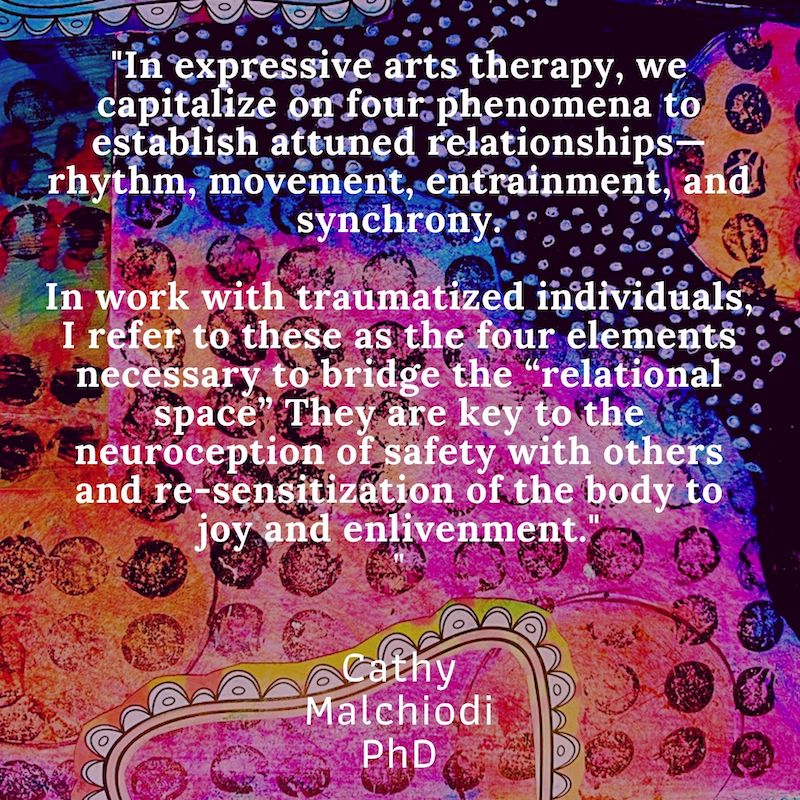Synchrony and entrainment are key rhythmic factors in health and well-being.

In expressive arts therapy sessions, we capitalize on four phenomena to establish attuned relationships-rhythm, movement, entrainment, and synchrony. These experiences are key to supporting experiences of enlivened social engagement and enhancing the neuroception of safety with others. In work with traumatized individuals, I refer to these as the four elements necessary to bridge the “relational space.”
Synchrony and Entrainment
Synchrony and entrainment are particularly important to enhance healthy connection and attachment. Entrainment refers to the physical process by which independent rhythmical systems interact with each other. Examples of naturally occurring rhythmical systems within the human body include the heartbeat, blood circulation, respiration, locomotion, and eye blinking. Women are familiar with female-related entrainment experiences that often occur including secretion of hormones and menstrual cycles. Animals’ rhythmic systems can also entrain us to their rhythms. For example, it is well-known among equine-assisted practitioners that forms of “cardiac coherence” can occur in humans in the presence of horses and vice-versa.
Synchrony is often confused with the concept of entrainment. Like entrainment, synchrony does involve rhythmic interaction, but the emphasis is on experiences that establish person-to-person bonding. This “interpersonal synchrony” includes rhythmic coordination of actions, emotions, prosody, and even thoughts between individuals. Research underscores that the formation of interpersonal synchrony is the essence of reciprocal interactions between infants and their caregivers (Brooks, et al, 2019). Simple forms of synchrony include clapping together in rhythm with a child, laughing together with friends, or nodding in agreement with your partner. We often spontaneously adjust our responses to be “in sync” with those around us and, in particular, individuals with whom we have affiliative or pro-social relationships.
In expressive and somatosensory work, we purposively support synchrony through experiences of singing, moving, or speaking together. The inherent harmony induced by these experiences, of being in a group in similar rhythm and cadence together, brings greater emotional closeness and rapport. It is a form of co-regulation that reinforces a sense of safety, comfort, and connection.
Collective Effervescence
There is a type of synchrony that connects individuals in powerful and far-reaching ways-it’s called collective effervescence. This concept was first described by Emile Durkheim in Elementary Forms of Religious Life, a study of religions with a focus on rites and rituals. In these events, he observed a vibrant energy that flowed through communities when participating in a ritual together. Essentially we merge with the group’s flow; it is a shared experience that often brings about strong emotion and even euphoria. Durkheim believed that the high emotional arousal resulting from this intense form of social sharing empowers us and touches us in deep, often implicit ways.
The phenomenon of collective effervescence has now been studied for many decades. It is now clear that it is not only part of rites and rituals, but also occurs throughout other types of shared actions. As Durkheim observed, it is a potent and impactful human phenomenon and one that we seek to find. In this current period of physical distancing and separation, we crave it so much we were sometimes willing to break rules to experience it. The sense of energy and harmony we feel when we come together in a group around a shared purpose is not only driven by individual need. It is a homing signal, an internal barometer of well-being and perceived health.
In researching this post, I learned that Emile Durkheim first wrote about collective effervescence a few years before the Spanish flu outbreak began, a moment in history mirrored in present times. As the aftermath of that 20th-century pandemic waned, what came to be called the “Roaring Twenties” emerged. In some parts of the world, that decade became a time of creative collaboration, a tremendous upsurge in the arts and innovations. As we move through this current pandemic, I wondered if we will see a similar uptick in collaborative output outside of Zoom screens or device-driven connecting.
This bit of history is at least one hopeful thought I am hanging onto amidst what appears to be yet another pandemic pivot at the moment. I am looking forward to the next time I can slip into rhythm with others on a dance floor; to sit amid fellow artists in creative collaboration; to be in a discussion session at a professional conference; and to sing, drum, and strum in the same room with fellow would-be musicians. Re-sensitizing the body, especially after many difficult months of immobilization and physical distancing, is essential to our collective recovery. And it is collective effervescence that may be the creative synchrony many of us desperately need.

